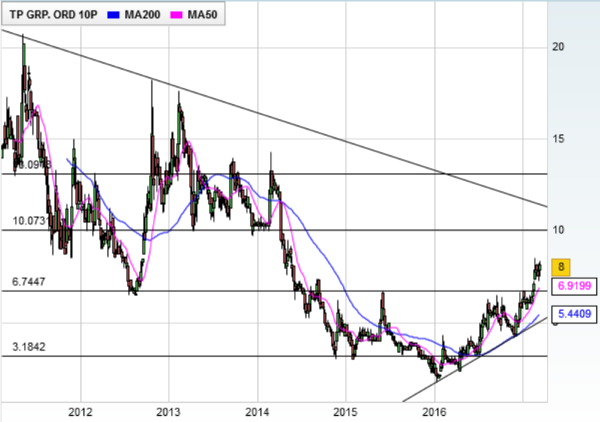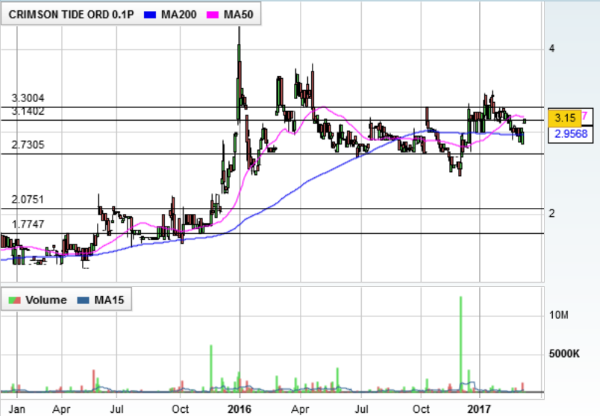A trio of AIM growth shares for your ISA
10th March 2017 13:21
by Andrew Hore from interactive investor
Share on
Following my recent article on income producing AIM companies that will be good investments for ISAs, this week I have three suggestions for anyone seeking growth companies to put in their tax-free wrapper. All three have good organic and/or acquisitive growth prospects.
TP Group
8.13p
used to be known as Corac and it has a quoted history going back two decades when it started off on Ofex (now NEX Exchange). Originally a development company focused on compressor technology, it has been transformed into a specialist engineering group since Phil Cartmell took charge in 2009, and it finally moved into profit in 2016. A strong order book means that the profit should grow from now on.
The design and technology business is still a contributor to revenues, but it is focusing on R&D financed by clients and supporting other parts of the group. The other divisions are maritime, engineering and managed services.
The maritime division dominates revenues and supplies air purification and filtration systems for submarines. Two UK contracts worth £50 million were won last year, providing a long-term base for the business. The Ministry of Defence is a major customer but there is also overseas business.
The engineering division manufactures heat exchangers, pressure vessels and fabricated components, as well as supplying related services. This part of the business is exposed to the oil and gas sector, but the customer base is being widened.
Managed services is focused on the aerospace and defence markets and the original work used to set up the operation was won by the maritime division. The division has been admitted to the G-Cloud procurement and other frameworks.
There is a dependence on the defence and oil and gas sectors and the latter has been weak, but TP is doing well despite this.
Past fundraisings and generation of cash from operations means that TP Group has a cash pile, which it has been using to make add-on acquisitions. Cash of £9.2 million is estimated for the end of 2016, but increased working capital for new contracts and acquisitions mean that cash will fall in 2017.

Further acquisitions could also use up the cash. There are four areas that have been identified for acquisition activity. They are control systems, security, simulation/ virtual systems and outsourced engineering services.
The 2016 figures will be reported on 4 April, but they have already been well-flagged. The 2016 profit will be relatively modest, but it is of great significance in the history of the group. Pre-tax profit is expected to treble to £1.8 million in 2017.
The share price has trebled from its low just under one year ago but the forward earnings multiple is expected to fall to less than 14 in 2018. Longer-term, dividends could be paid.
SigmaRoc
39.63p
An experienced construction materials sector management team took control of shell , formerly Messaging International, last summer. The first acquisition has been completed and this provides a solid base from which to build a larger business which will be valued at £500 million in five years if management can meet its targets.
Ronez was well known to the SigmaRoc management because some of them worked at its previous owner LafargeHolcim. Chief executive Max Vermorken was involved in the integration of businesses following the merger of Lafarge and Holcim, so he has knowledge of a number of operations in the group. Operations manager Charles Trigg was previously head of capital expenditure at LafargeHolcim Northern Europe.
This experience significantly reduces the risk of the £45 million deal. Ronez dominates the Channel Islands aggregates market, so growth is limited, but it is cash generative. It provides a range of products including aggregates, ready-mixed concrete, asphalt and pre-cast concrete products.
Ronez is not a fast-growing business, but it will throw off cash to help fund group overheads and further acquisitions. However, the scale of potential acquisitions will require further share issues.
Acquisitions are likely to be in niche areas where there is limited competition from large rivals in the sector. Mergers in the construction materials sector are likely to present opportunities to pick up other assets that are non-core.
There are also potential partnership and investment opportunities with the majors in the sector. In these opportunities SigmaRoc could provide capital needed for investment in return for a share in the uplift in profitability.
SigmaRoc is expected to have cash of £4 million at the end of 2017 and it is negotiating a £18 million term facility with Santander, which has already supplied a £2 million revolving credit facility. These facilities will last until 2021.
The recent positive trading statement said that the integration of Ronez was ahead of schedule and the installation of new systems should be completed in April at a lower than expected cost. Trading in January was ahead of expectations and the order book is strong.
The initiation research from house broker Zeus, published before the trading statement, expected a pre-exceptional profit of £2.7 million this year, edging up to £2.8 million next year.
In reality, that is the base profitability of the business with further acquisitions likely to enhance profit and earnings. The share price has slipped below the 40p placing price for the Ronez acquisition. The shares are trading on 16 times prospective 2018 earnings with the potential for earnings enhancing acquisitions.
Crimson Tide
3.1p
has steadily built up a significant business over the past decade. It has taken a long time, but the benefits of the patient investment and development are showing through in terms of recurring revenues and profit.
Crimson Tide's mpro5 mobility-as-a-service technology is designed to enable workers that need to be mobile to undertake orders, and other tasks, via their handheld device instead of on paper. This makes processes more efficient. The technology can be used on any platform, including tablets and smartphones. Logistics, retailing, manufacturing and pharmaceuticals are some of the more important sectors to Crimson Tide.
Contracts won tend to fully benefit the following year, so the contract momentum last year should ensure further growth in profit in 2017. The completion of the major contract with a supermarket operator ahead of schedule at the end of 2016 means there will be a full-year contribution in 2017. There was an initial pilot and then a four-year contract, covering nearly 500 stores, worth a total of £1.7 million.
To put this in perspective, Crimson Tide's 2014 revenues were £1.2 million, so the contract will provide around one-third of that figure on its own.

The cost base has been kept under control, but the opportunities to grow in international markets are likely to require additional overhead investment. Laurence D'Arcy, who headed up the business in Ireland, will oversee international expansion
Crimson Tide is joining pharma trade body RX360, which includes 18 out of the top 20 global pharma companies, and this should provide a way of building a presence in the US. Pilot schemes are underway and a small US office will be opened later this year.
Crimson Tide has already confirmed that 2016 revenues were at least £1.75 million and the pre-tax profit more than doubled to £400,000. The final figures are likely to be published in April. There is scope for that profit to double again this year, although it could depend on the level of international investment needed. There is even the possibility of a dividend in the near future following a capital reconstruction so that there are distributable reserves.
The share price is around the same level it was one year ago prior to a spike upwards, and trade on around 30 times 2016 estimated earnings. But that rating could halve this year and the growth momentum is set to continue.
Crimson's share price had got ahead of itself 15 months ago, but it has drifted back and the company's performance is catching up with it. The recurring revenues base means that management can reinvest to grow further in the confidence that overheads are covered by regular cash flow.
This article is for information and discussion purposes only and does not form a recommendation to invest or otherwise. The value of an investment may fall. The investments referred to in this article may not be suitable for all investors, and if in doubt, an investor should seek advice from a qualified investment adviser.
These articles are provided for information purposes only. Occasionally, an opinion about whether to buy or sell a specific investment may be provided by third parties. The content is not intended to be a personal recommendation to buy or sell any financial instrument or product, or to adopt any investment strategy as it is not provided based on an assessment of your investing knowledge and experience, your financial situation or your investment objectives. The value of your investments, and the income derived from them, may go down as well as up. You may not get back all the money that you invest. The investments referred to in this article may not be suitable for all investors, and if in doubt, an investor should seek advice from a qualified investment adviser.
Full performance can be found on the company or index summary page on the interactive investor website. Simply click on the company's or index name highlighted in the article.
Disclosure
We use a combination of fundamental and technical analysis in forming our view as to the valuation and prospects of an investment. Where relevant we have set out those particular matters we think are important in the above article, but further detail can be found here.
Please note that our article on this investment should not be considered to be a regular publication.
Details of all recommendations issued by ii during the previous 12-month period can be found here.
ii adheres to a strict code of conduct. Contributors may hold shares or have other interests in companies included in these portfolios, which could create a conflict of interests. Contributors intending to write about any financial instruments in which they have an interest are required to disclose such interest to ii and in the article itself. ii will at all times consider whether such interest impairs the objectivity of the recommendation.
In addition, individuals involved in the production of investment articles are subject to a personal account dealing restriction, which prevents them from placing a transaction in the specified instrument(s) for a period before and for five working days after such publication. This is to avoid personal interests conflicting with the interests of the recipients of those investment articles.